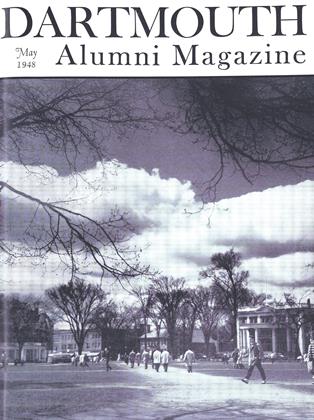by Oscar Theodore Barck Jr.and Nelson Manfred Blake '30. The Macmillan Company, 1947 Pp. 862. $4.75.
According to tradition most survey courses in American History treat in the first semester events from about 1776 to 1865 and in the second semester the period from 1865 to the present. This generalization held thirty years ago, when this reviewer first touched college history, and still holds in 1948 In the meantime, of course, the events of these thirty crowded years have been added to the content of the second semester with the result that this course which before World War I covered only a fifty-year span now approaches the time span of the first semester and with a story infinitely more detailed and complex and less thoroughly digested. Some teachers have moved the dividing line ahead from 1865 to 1876 or even 1890 while others have added a new course covering events since 1900. For such a course this text by Messrs Barck and Blake furnishes an admirable basis.
It represents a conservative treatment and some will criticize it as being too largely political. Chapters one, fifteen, and thirty are surveys of the social and cultural picture at about 1900, 1920, and 1940 respectively. The remaining twenty-seven chapters deal almost exclusively with governmental problems—political, economic, and military—domestic in background yet becoming to an increasing degree international in scope. The authors succeed in large measure in their aim to be impartial and non-partisan and to let their carefully marshalled facts proclaim their own compelling lesson.
Instead of court-house squares and postoffice murals the book presents for illustrations a reasonable number of appropriate photographs plus representative cartoons by such masters as Darling and Fitzpatrick, Bishop and Kirby and McCutcheon. It contains good suggestions for further reading, an adequate index and no cumbersome appendices or supplements.
The increasing desire for a fuller treatment of the more immediate past is reflected even within the forty-five year span covered in this volume for of its 800 odd pages only 250 are used to carry the twenty-year story through World War I while the remaining 550 pages cover the slightly longer period from 1920 to 1945. One has to concede, of course, that F.D.R. had something to do with the amount of space required! Question as we may what sometimes seems an over-emphasis on study of the contemporary it is impossible to deny the importance of events since the turn of the century. In the study and evaluation of those events this volume makes a welcome contribution.
 View Full Issue
View Full Issue
More From This Issue
-
 Article
ArticleTHE MEANING OF TOLERANCE
May 1948 By W. K. JORDAN -
 Class Notes
Class Notes1918
May 1948 By ERNEST H. EARLEY, DONALD L. BARR, DAVID L. GARRATT -
 Article
ArticleDartmouth Today is His Tribute
May 1948 By WILLIAM H. HAM -
 Class Notes
Class Notes1919
May 1948 By J. K. HUNTINGTON, MAX A. NORTON, ROSCOE A. HAYES -
 Class Notes
Class Notes1942
May 1948 By JAMES L. FARLEY, JOHN H. HARRIMAN, ADDISON L. WINSHIP II -
 Article
Article"Pest House" Days
May 1948 By ALICE POLLARD
Allen R. Foley '20.
Books
-
 Books
BooksMICHELANGELO, THE MAN
June 1935 By Hugh S. Morrison -
 Books
BooksMaintaining a United Front
NOVEMBER • 1985 By Mark Woodward '72 -
 Books
BooksHAPPY BIRTHDAY TO YOU!
November 1959 By MAUDE D. FRENCH -
 Books
BooksWhale of a Man
May 1981 By Peter C. Grenquist '53 -
 Books
BooksGalaxies
November 1979 By Robert H. Ross '38 -
 Books
BooksSTATE AND LOCAL GOVERNMENT.
NOVEMBER 1962 By VIRGINIA L. CLOSE




